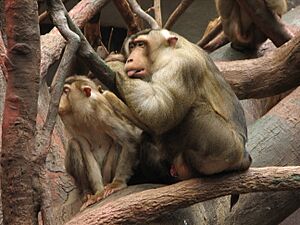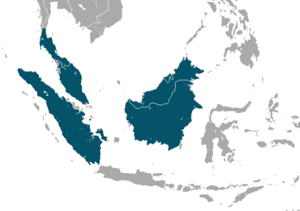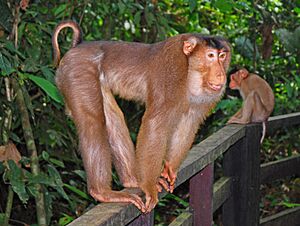Southern pig-tailed macaque facts for kids
The southern pig-tailed macaque (Macaca nemestrina) is a medium-sized monkey. It lives in parts of Southeast Asia, including southern Thailand, Malaysia, and Indonesia. People in these areas sometimes call it berok.
Quick facts for kids Southern pig-tailed macaque |
|
|---|---|
 |
|
| At the Prague Zoo, Czech Republic | |
| Conservation status | |
| Scientific classification | |
| Genus: |
Macaca
|
| Species: |
nemestrina
|
 |
|
| Southern pig-tailed macaque range | |
| Synonyms | |
|
|
Contents
About the Southern Pig-tailed Macaque's Name
The scientific name for this macaque is Macaca nemestrina. The word nemestrina comes from a Latin word meaning "god of groves." This name was chosen to match the scientific group name, Macaca.
In the past, scientists thought that the southern pig-tailed macaque was one species with a few different types. These types were called northern pig-tailed, Pagai Island, and Siberut macaques. Now, scientists consider all four of these to be their own separate species.
What Does a Southern Pig-tailed Macaque Look Like?
Like other Macaca monkeys, male southern pig-tailed macaques are bigger than females. Males are usually about 50 to 58 centimeters (20 to 23 inches) long. They weigh between 5 and 12 kilograms (11 to 26 pounds).
Females are smaller, measuring 38 to 48 centimeters (15 to 19 inches) long. They weigh about 4.5 to 6 kilograms (10 to 13 pounds).
These macaques have fur that is a light brown color, called buff-brown. Their back is darker, and their belly is lighter. Their common name comes from their short tail, which sticks up a bit, looking like a pig's tail.
How Southern Pig-tailed Macaques Live and Eat

Southern pig-tailed macaques mostly live on the ground. However, they are also very good at climbing trees. Unlike many other monkeys, they enjoy water.
They live in large groups. During the day, when they are looking for food, these large groups often split into smaller ones. They eat many different kinds of food, which means they are omnivorous. Their diet mainly includes fruits, seeds, berries, grains, mushrooms, and small bugs.
A study in Malaysia showed that these macaques are important for spreading the seeds of certain types of rattan plants. They might even be the only animals that spread these seeds.
Social Life and Family Groups
Within their groups, there is a clear order, or dominance hierarchy. Among males, this order is based on how strong they are. Among females, the order is passed down through the family. This means that the daughter of the most important female will automatically be higher up in the group than other females.
The most important female, called the alpha female, leads the group. The males' main job is to help solve problems within the group and protect everyone.
Reproduction and Life Cycle
Female macaques are pregnant for about 5.7 months. They usually give birth to one baby every two years. The babies drink their mother's milk until they are about 4 to 5 months old. Young macaques become adults and can have their own babies when they are 3 to 5 years old.
Where Southern Pig-tailed Macaques Live
This macaque mostly lives in rainforests, even high up in mountains (up to 2,000 meters or about 6,500 feet). They can also be found in farms and gardens.
You can find them in the southern part of the Malay Peninsula, which just reaches into southern Thailand. They also live on the islands of Borneo, Sumatra, and Bangka Island. There were reports of them in Singapore before 1950, but these were likely pet monkeys that escaped. Any pig-tailed macaques in Singapore today were brought there by humans.
Southern Pig-tailed Macaques and People
For hundreds of years, people in Southeast Asia have trained monkeys, including the southern pig-tailed macaque, to help them harvest coconuts. These monkeys are skilled at climbing trees and picking the coconuts.


